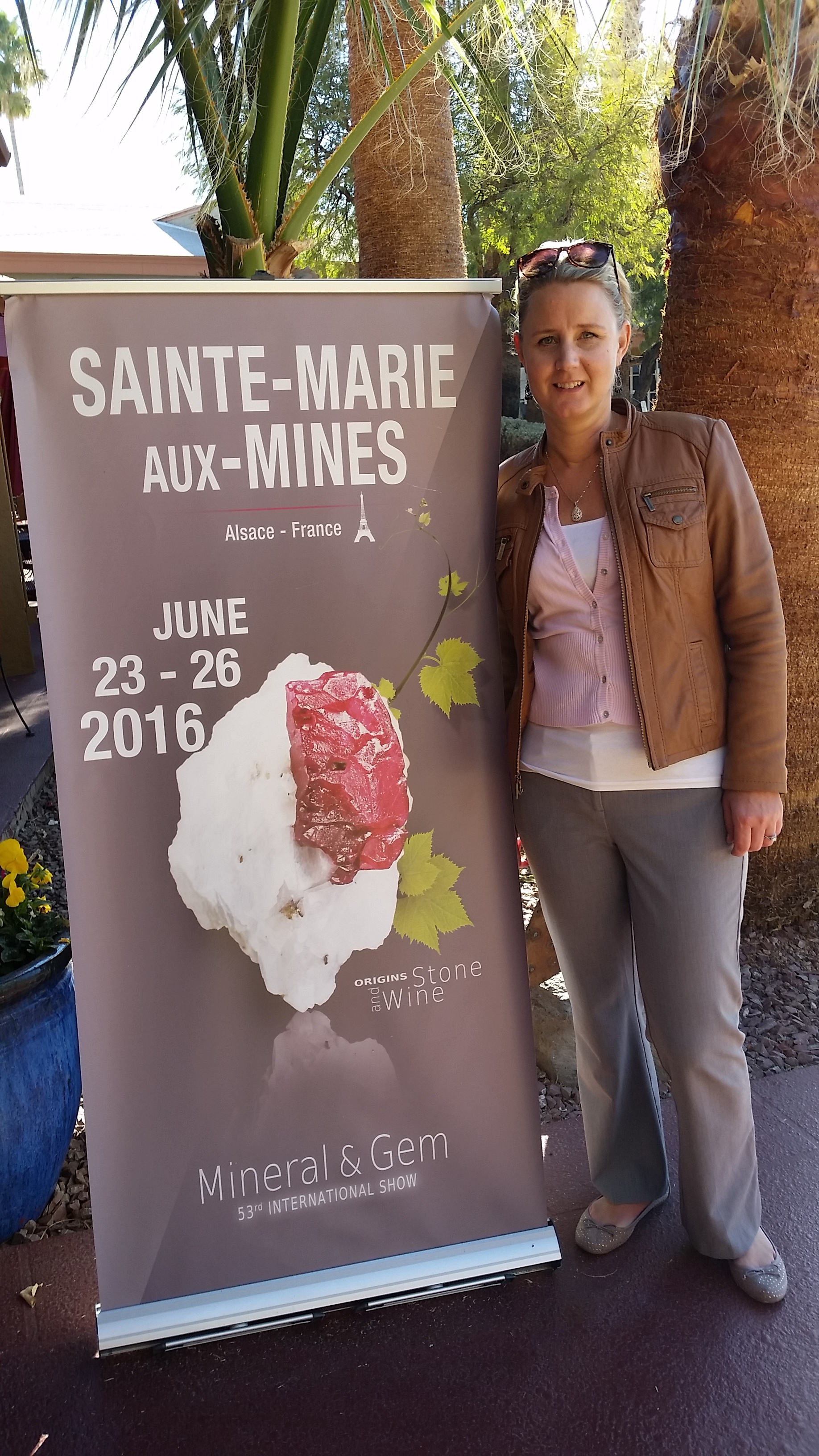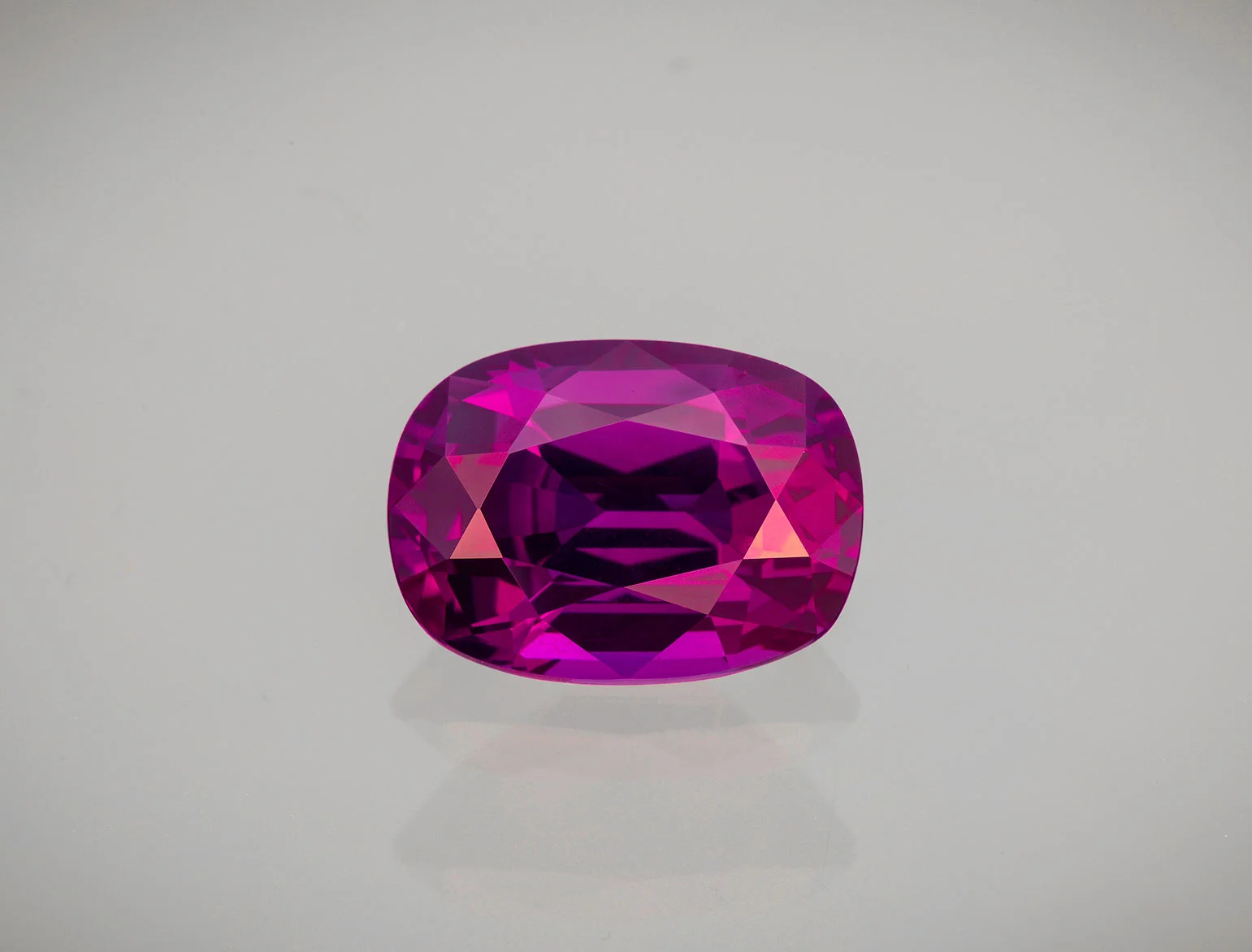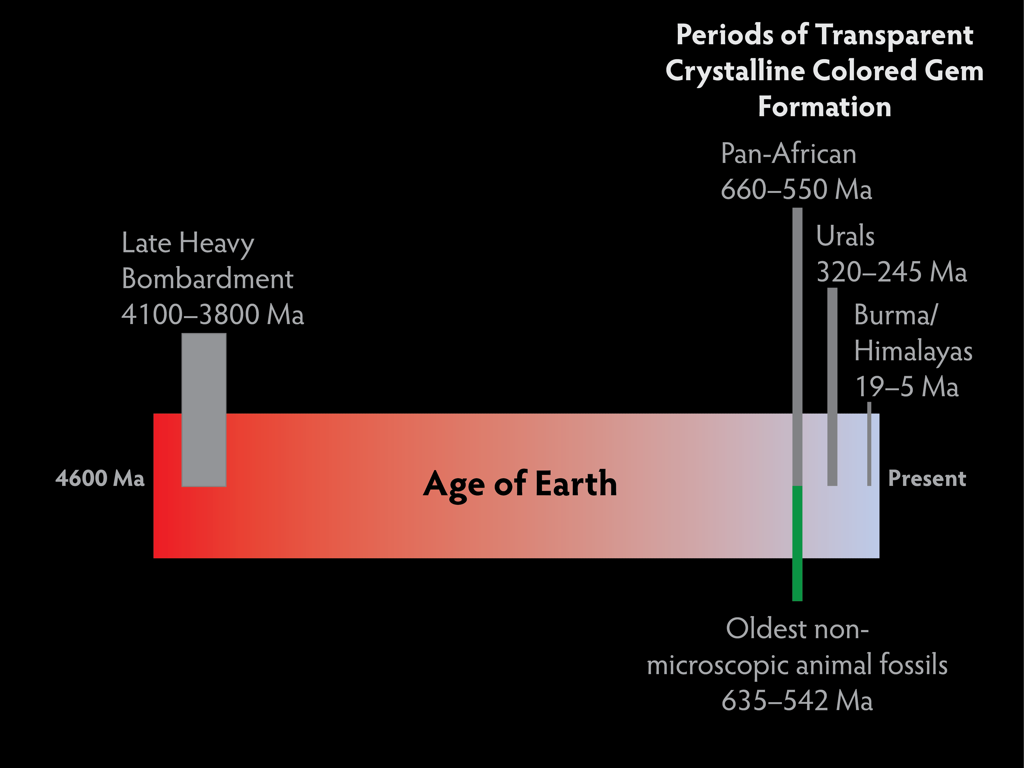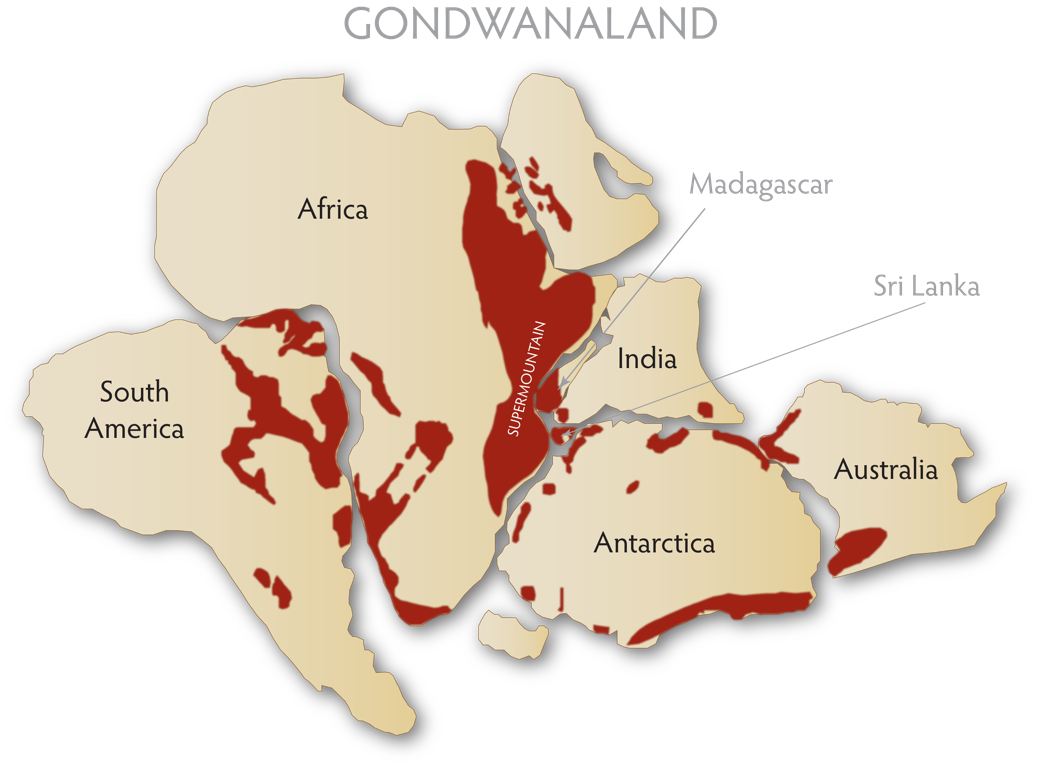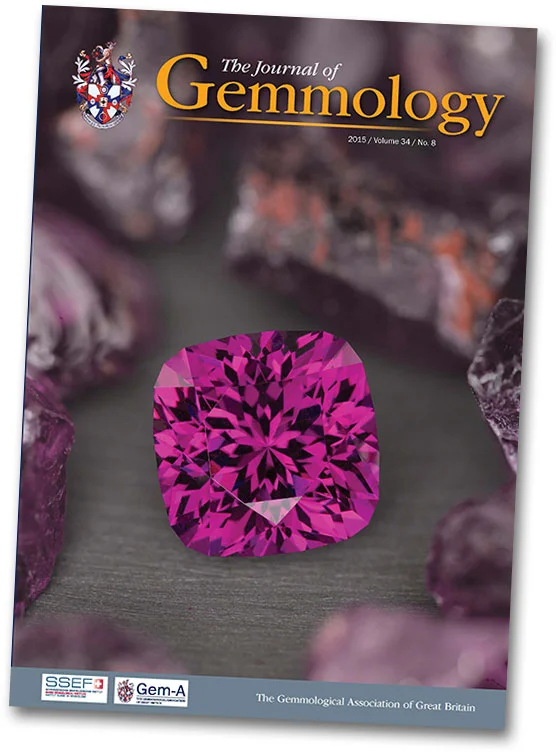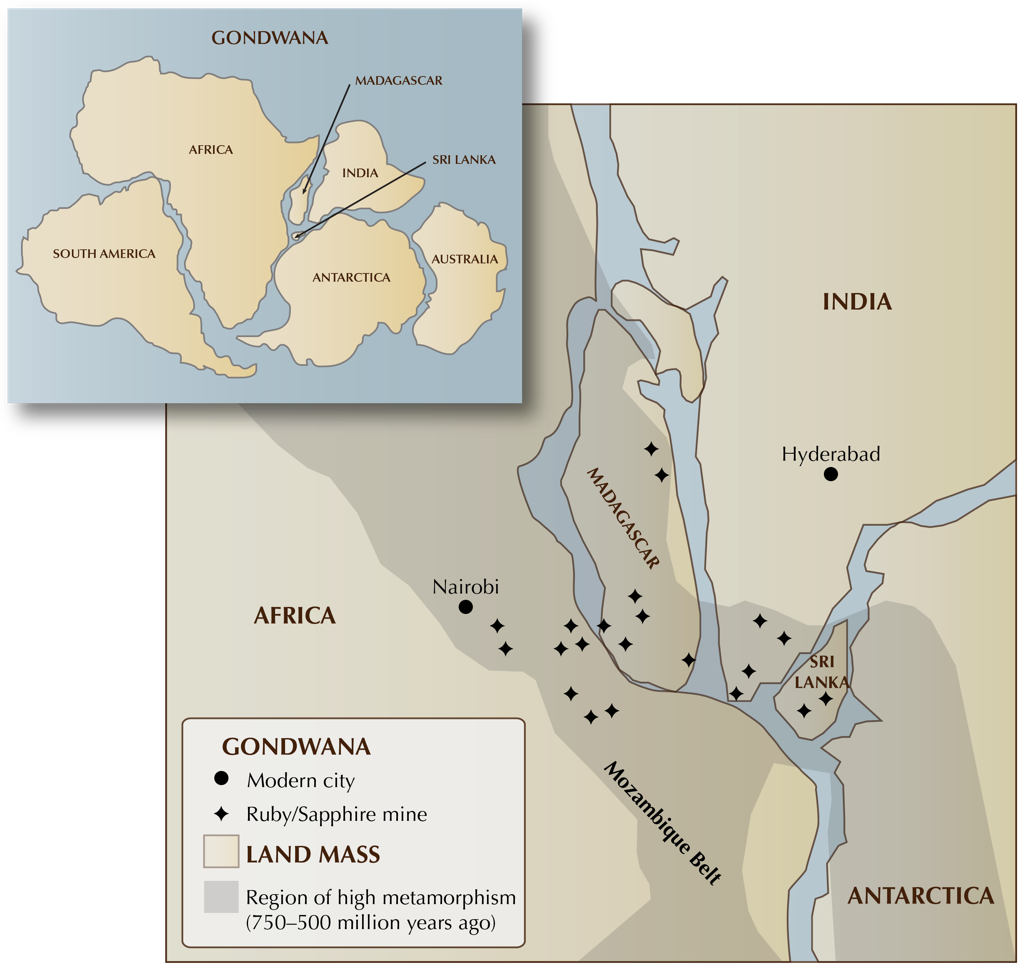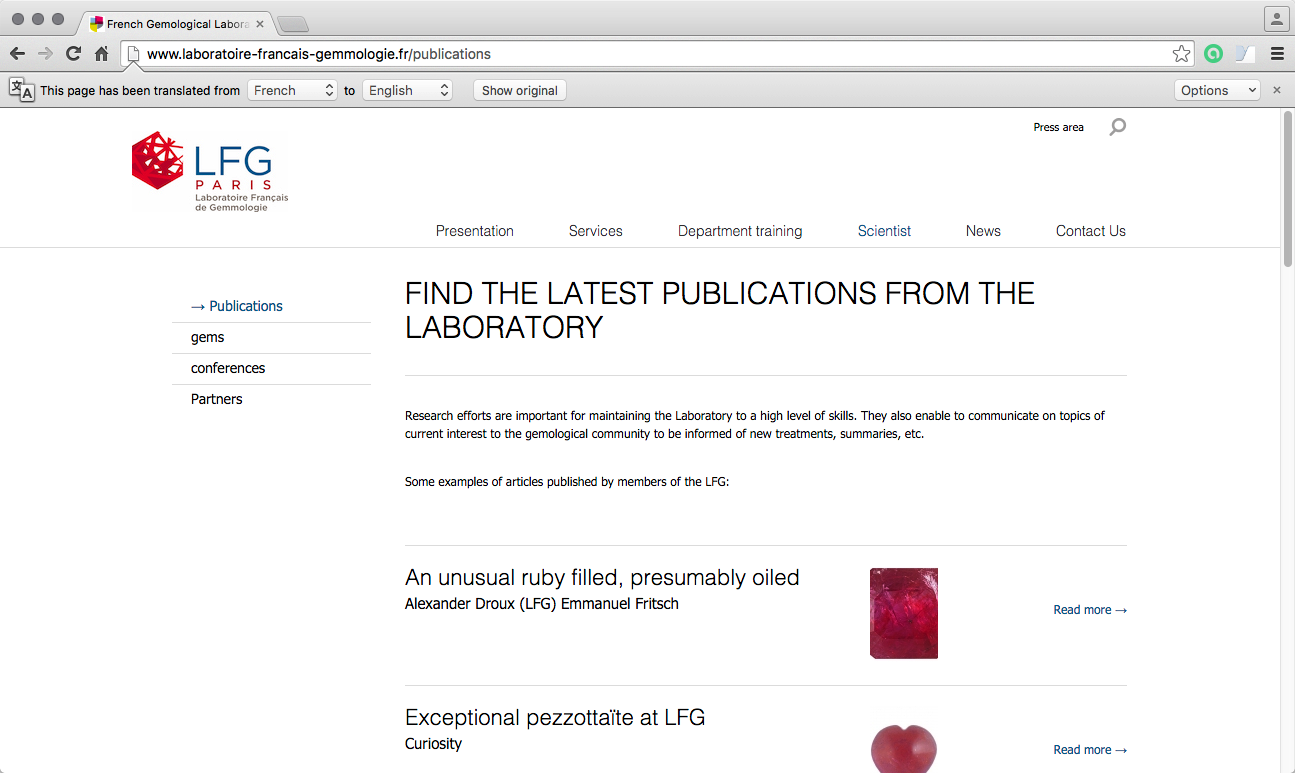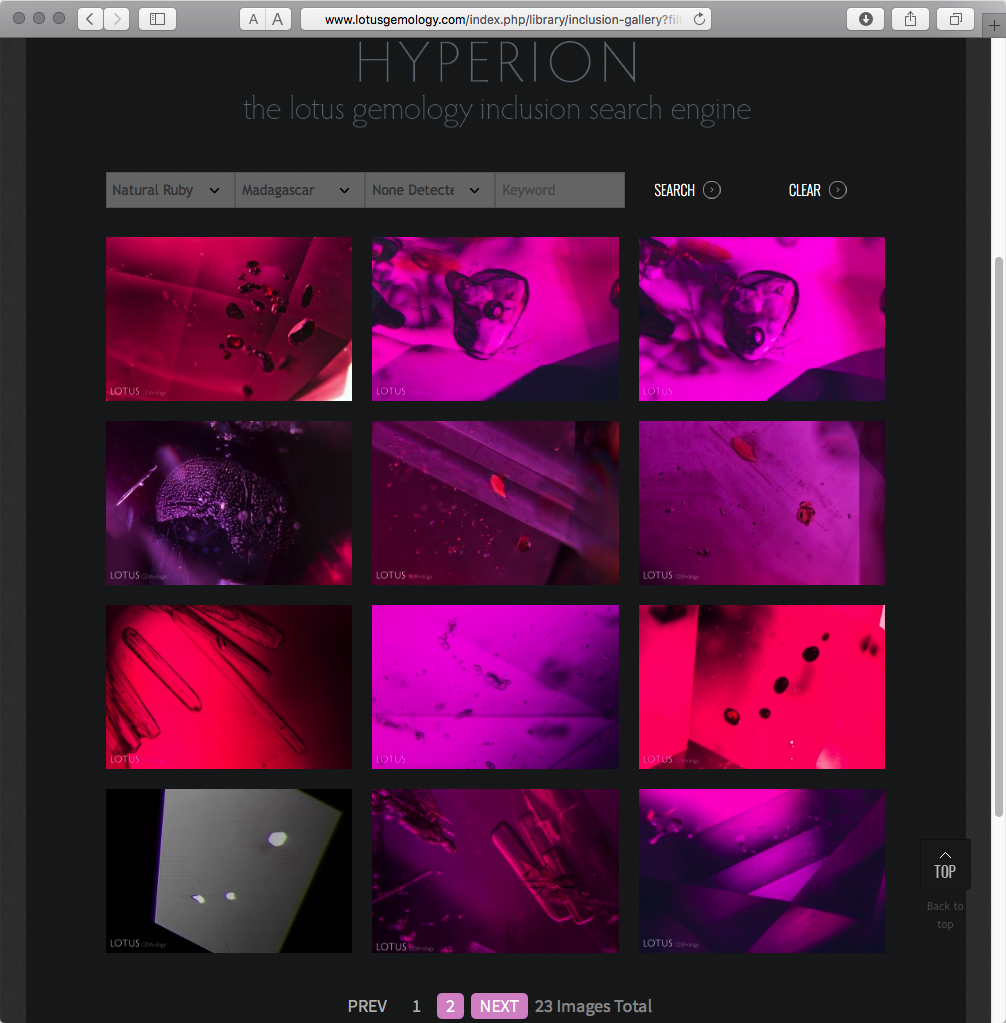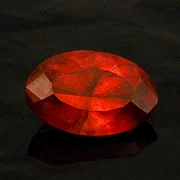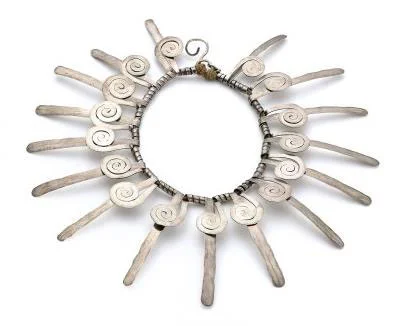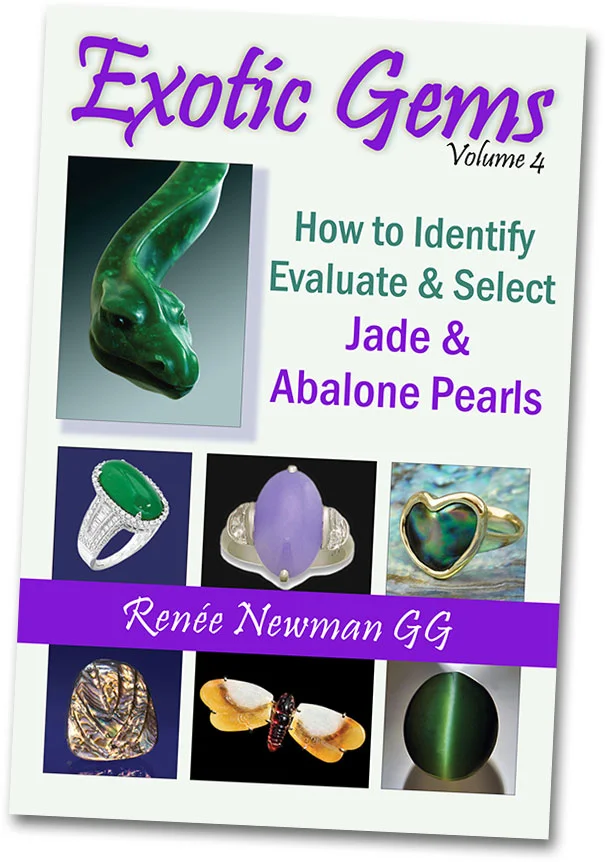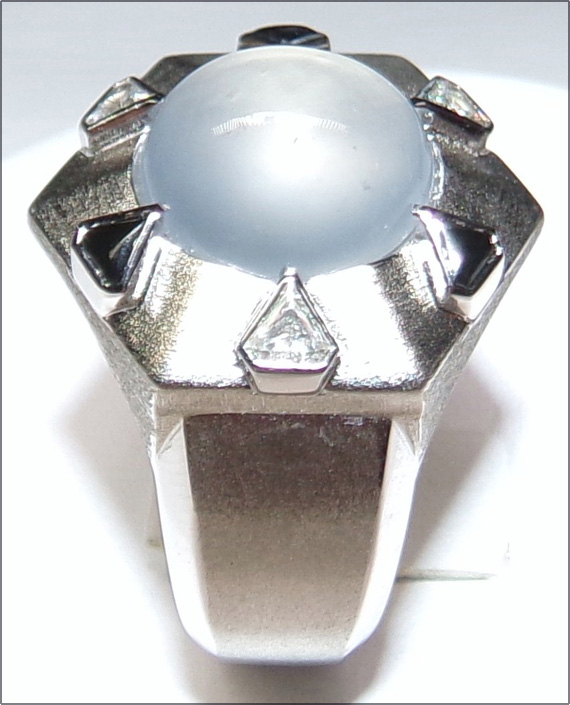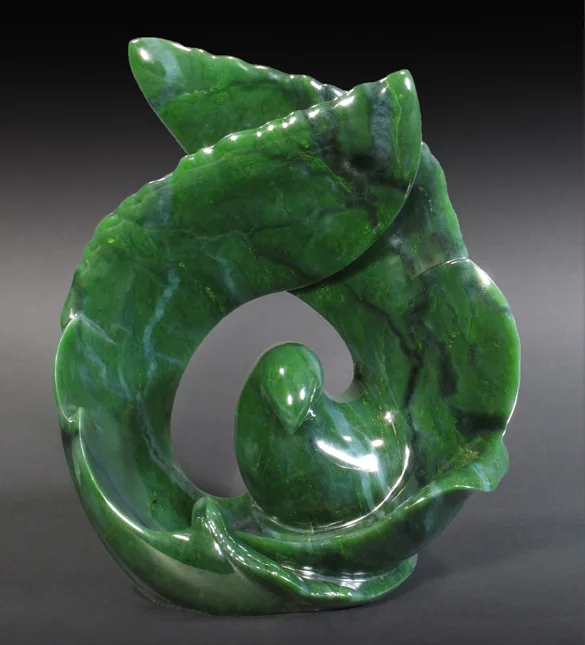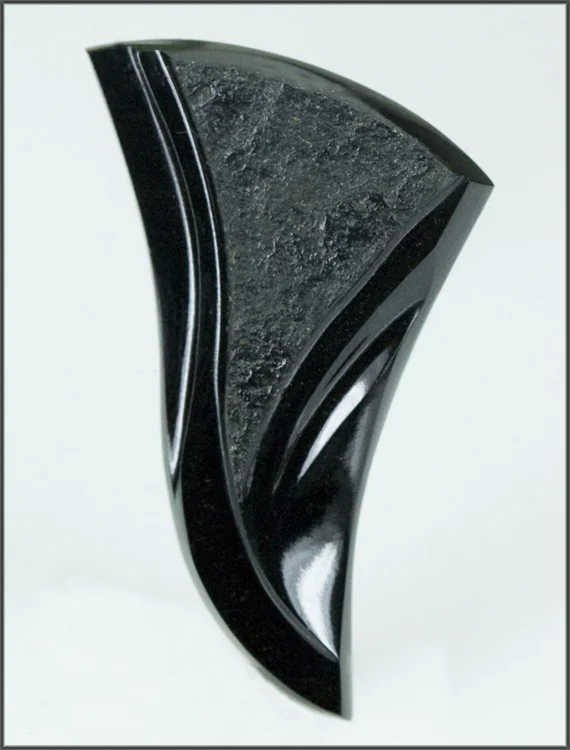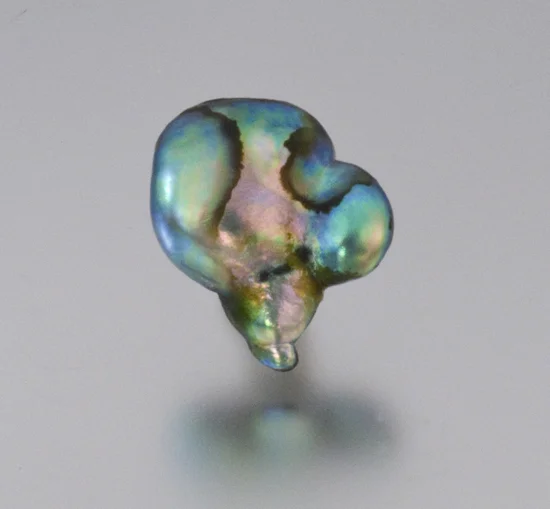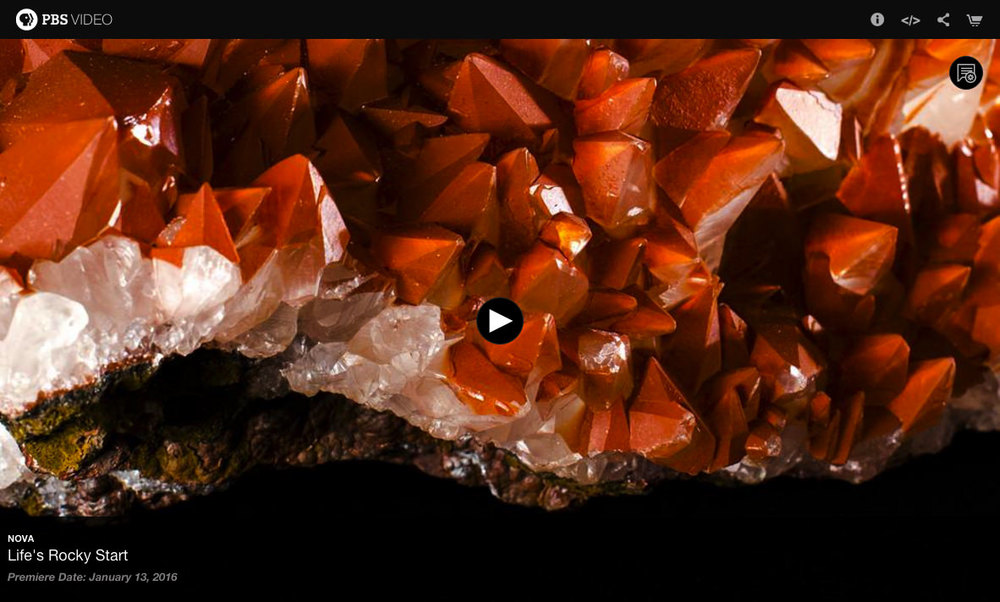February 2016
February 2016
Gemmy/Jammy. Mia Dixon, Pala International's resident photographer, taking a break from the Tucson show last week, stands beside a poster for the upcoming Sainte-Marie show. The specimen on the poster was shot by master photographer Jeff Scovil, with whom Mia studied at the show. The theme of the Prestige exhibition at Sainte-Marie this year is "Origins: Stone and Wine." This is une alliance dear to the hearts of the Pala People. (See "Flashes of Colour: Legendary Wines and Gemstones" from 2007.)
Table of Contents
Shows and Events
Pala International News
Gem and Gemology News
Industry News
- Selling the Steel Butterfly's Stones
- Miners as Marketers See Payoff
- Miners as Marketers See Selloff
- Sotheby's Sale of Wearable Art
- Burma Bits
Books
- Exotic Gems, Volume 4
by Renée Newman
Pala Presents
- City Built on Rubies
by W. G. Fitz-Gerald
Recycle Bin
- Life's Rocky Start
by NOVA
Editor: David Hughes
Shows and Events
Annual Sinkankas Symposium Postponed
One of the perennial joys of early spring in California's Southland is the Annual Sinkankas Symposium. Gemstone enthusiasts anticipated this year's April 9 meeting, on the subject of sapphire. The 14th Annual Sinkankas Symposium has been postponed, however, due to the death of its organizer, Roger Merk. The following notice is posted on the event's website.
The annual event was conceived by Roger to honor his friend, John Sinkankas, who passed away in 1982. Roger organized thirteen programs, beginning with Quartz in 2003. The last program he oversaw was the 2015 event showcasing Opal. The Sinkankas Symposium was one of Roger's finest achievements, and it was his intention that his legacy should continue. Over the years, many people helped put on the annual event, and they share in Roger's desire that it would continue. The 2017 symposium is dedicated to Roger, in recognition of his dedication to educate and inspire mineralogists, gemologists, and the public through The Sinkankas Symposium.
The symposium will take place on Saturday, April 8, 2017 at the GIA worldwide headquarters and Robert Mouawad Campus in Carlsbad, California, where it has been held for the previous thirteen events. It is sure to sell out, so visit the symposium website and join the mailing list to make sure you stay in the loop.
Pala International News
Pala's Featured Gemstone
Umbalite Garnet from Tanzania
This month we feature an umbalite garnet from Tanzania.
Umbalite garnet from Umba, Tanzania, 7.90 ct, 13.0 x 9.4 x 6.8 mm. This has been sold. (Photo: Mia Dixon)
This 7.9-carat umbalite garnet has a striking color, unlike many we have seen come from the Umba valley in Tanzania. The melange of pyrope, almandine, and minor spessartite produces a striking mix of maroon, purple, and magenta in this unique gem. Reminiscent of a fine dark purple sapphire, this umbalite shifts through these hues depending on the lighting. Very clean and well cut, this piece really sings in the daylight.
Interested? Contact us!
Gem and Gemology News
Research Roundup
Below are several items emanating from four gem labs in Europe and Asia.
The Journal of Gemmology: Age Determination of Zircon Inclusions in Faceted Sapphires
Gemologist and author Richard W. Hughes has touched on the subject of colored gemstone formation by time-period and geographic location for the last couple of years, beginning with the February 2014 AGTA GemFair, and as recently as earlier this month at the AGA Cutting Edge Gemological Conference in Tucson. At the 2015 Hong Kong Show last fall, Dr. Daniel Nyfeler, Managing Director of Gübelin Gem Lab, devoted an entire talk on the topic, titled "The Age of Gemstones."
As can be seen from one of the slides from Hughes's presentation above, and as he likes to point out, crystalline colored gem formation took place at roughly the same time as "life as we know it," i.e., the development of non-microscopic animals. The basis for this is contained in John Saul's book, A Geologist Speculates, which we noted in October is available for free download via Hughes's Lotus Gemology website.
As also can be seen in Hughes's slide, gemstones formed in different geographic regions during different periods. Those areas are illustrated in another slide from Hughes's presentation, below.
Gemstone occurrences in red, in the supercontinent dubbed Gondwanaland by paleogeographers. This is adapted from John Saul's A Geologist Speculates. (Illustrations: R. W. Hughes)
On January 25 of this year, Gübelin Gem Lab announced it now employs a new technology that can aid in determining the age of some colored gemstones. The age data then can be compared with the known periods of formation for given geographical regions, pointing to locality of origin, a driver of value for many fine colored stones. The lab announced that its methodology would be covered in an article in The Journal of Gemmology. The result is a nine-page study of the process by Klemens Link, the lab's geochemical specialist, appearing in the current Journal (34[8], 2015), titled "Age Determination of Zircon Inclusions in Faceted Sapphires."
Locality of origin determination has been done for some time using special spectrometry (laser-ablation–inductively coupled plasma–mass spectrometry, LA-ICP-MS) on research samples, where destruction of the sample was not an issue. The task was to access the zircon crystals within the matrix in order to measure their uranium-lead (U-Pb) ages. Faceting a gemstone also can reveal zircon grains or crystals at the surface. Only since July 2015 has the Gübelin Gem Lab been taking advantage of this reality, i.e., using LA-ICP-MS on client-submitted stones when 1) the crystals are exposed and 2) age determination is necessary for identification of locality, say, separating Burmese blue sapphires from those from Madagascar. The procedure also can reveal information about heat treatment.
This study describes the process performed on two fancy-color sapphires weighing more than 12 carats. Corundum itself cannot be age-dated via the U-Pb method, so zircon in the host (matrix) must be accessible. The challenge is to leave no eye-visible evidence of the laser's work on the surface of the stone and not to subtract from its weight. Thus the stone's girdle usually is the point of sampling. An abstract of the study provides the high-level results of the two stones' analysis.
Routine lab analysis already had pointed to Madagascar origin for both stones. LA-ICP-MS results from the pink sapphire seemed to confirm this, but the study concluded that more research is required on Madagascar and other Pan-African-related sapphire age populations before they can provide "hard criteria" for determining origin. The greenish blue sapphire's zircon analysis led to investigation into the nature of the zircon itself, requiring complicated interpretation.
Detail of the proximity in Gondwana of the important ruby and sapphire mines of East Africa, Madagascar, Sri Lanka and southern India some 750–500 million years ago. From Ruby & Sapphire: A Collector's Guide by Richard W. Hughes. (Illustration: R. W. Hughes)
As mentioned above, the zircon analysis could indicate heat treatment. The jury may still be out on whether heating leads to loss of lead (Pb) in zircon inclusions, and its significance; the heating could come naturally from high-temperature metamorphism. Nevertheless the study appears to account for this.
The study addresses one more wrinkle regarding zircon: complex zoning. Highly zoned zircons indicate different times of formation. And there's an app for that, so to speak, and it doesn't appear to require more sample size than LA-ICP-MS.
The study concludes that LA-ICP-MS is viable for determining zircon inclusion age and that it may become a routine or elected procedure. There are limiting conditions, however….
Brush up on your Deutsche and visit the Gübelin Gem Lab in Lucerne via Swiss Radio and Television's Einstein series. Watch video »
• • • • •
GIA Thailand: Field Expedition Videos
GIA Thailand continues to post new streaming videos documenting its field expeditions. On tap are videos for Field Expeditions 67 and 73, Australian Opals: A passionate journey and Madagascar Ruby Rush.
Australian Opals: A passionate journey
GIA FE67 took place in June 2015, visiting Australia's sapphire and opal mining areas. The opal expedition began with Lightning Ridge's black opals, then on to boulder opal country with the Koroit, Yowah and Quilpie areas. The Australians depicted here live up to their reputations as passionate individualists. Watch video »
Madagascar Ruby Rush
GIA FE73 took place September 23 through October 6, 2015, beginning in the Madagascar capital of Antananarivo in the center of the country, with the goal of visiting a new ruby find in Zahamena National Park, to the northeast, and just north of Didy, site of an earlier corundum clamor. (See "Giddy in Didy" from December 2012.) It's no easy ride, however, as cars are abandoned for clodhoppers. Finally they reach the source. "Probably we'll have to do that again next year," says GIA's Vincent Pardieu—before he's made the trek back. Watch video »
• • • • •
LFG: An Unusual Filled Ruby, Presumably Oiled
Laboratories Français de Gemmologie (LFG) posted a report on a 12.12-carat red gemstone, which easily was identified as ruby. Further, its inclusions and chemistry suggest its origin as Burma. The stone is highly included and close examination of its fractures revealed filling material, becoming whitish near the surface. Heat from the optical fiber illumination flushed droplets from the cracks. The infrared spectrum confirmed the material to be organic.
Hmm. Where have we seen this before? Most recently in Lotus Gemology's April 3, 2015 Lab Alert (not included in LFG's references).
Google Translate comes in handy for foreign-language lab websites, like LFG. Or browse using Chrome, as above, which has the translator built in.
• • • • •
Hyperion: Lotus Launches Inclusion Database
At Christmastime, your editor was treated to a sneak peek by brother Richard Hughes of the latest offering from Lotus Gemology—Hyperion, an inclusion search engine. It takes its name from the Greek Titan who was called the God of watchfulness, wisdom and light. Gemologists surely benefit from all three.
Visitors will be overwhelmed by the microworld at hand. Well, not too overwhelmed since the database is limited to the area of the lab's specialty: ruby, sapphire and spinel, both natural and synthetic. There are more than 500 images to peruse. And the browsing's a breeze due to the versatile interface. Access Hyperion here »
We selected this "fingerprint" inclusion from the second row of results. Details about the image are provided, including a reference to Lotus's very early look (Sept. 2, 2015) at the new ruby find, "Let it Bleed – New Rubies from Madagascar." Lotus also provides a bibliography of the literature of gemstone inclusions.
Industry News
Selling the Steel Butterfly's Stones
Remember when Imelda Marcos's shoe collection was discovered in Malacañang Palace following the People Power Revolution of the Philippines in 1986? They once were rumored to be in the thousands, although the final tally was just over one thousand, as reported by Time magazine. To be fair, if I recall correctly, Marcos claimed she'd received most of the shoes as gifts from factories she'd toured.
Not so with the so-called Steel Butterfly's jewelry collection, although there undoubtedly was a gift or two to be found. The collection is approved for auction by the government of the Philippines, as announced yesterday. It was confiscated by authorities when Imelda and Ferdinand Marcos, who ruled the nation for twenty years (ten under martial law), fled the country thirty years ago this February 28. The collection is considered of such a caliber that it has been appraised by both Christies and Sotheby's. It is valued at about $21 million, according to JCK yesterday. BBC, also yesterday, reported that the government is eager to sell the jewels before elections in May, when the couple's son, Ferdinand Marcos Jr., runs for vice president, fearing he could halt the sale. The collection's worth is a drop in the bucket for the family and cronies who are said to have squirreled away more than $10 billion in assets while in power. The collection will be exhibited prior to the sale.
Experts appraise Imelda Marcos's jewellery collection, which includes Indian diamonds and Burmese rubies. Michaela Cabrera reports and David Warren, Christie's Senior International Jewellery Director, above, provides his assessment. Watch video »
Miners as Marketers See Payoff
"All about color." This 7.89-carat natural rhodochrosite hails from Zambia's nearby neighbor, South Africa. Inv. #18137. (Photo: Mia Dixon)
We last mentioned the Kagem Mine in Zambia six years ago, in regard to the "Elephant" emerald unearthed there by Gemfields. It was a huge 6,225-carat rough crystal named "Insofu" (elephant) by the local Bemba people. Last month, Wall Street Journal published an overview of the Gemfields operation, which involves mining, of course, but also marketing. (Gemfields acquired Fabergé in 2013.) Some of the statistics in the article are of interest.
Kagem is the world's largest emerald mine, producing millions of carats a month (the Zambian government has a 25% stake in the mine, Gemfields the rest). The mine's output has tripled since 2008 when, among other things, the firm hired geologists to target the best places to mine. (For a close-up of how mining engineers can use science and technology to aid in this type of determination, see our Research Roundup for April 2015, regarding GIA's field trip to Brazil.) Gemfields' total revenue for fiscal year ending last June 30 was $171 million.
World-wide emerald prices have increased almost 1400% since 2009. Gemfields' price for high quality rough from Kagem has gone from $4.40/ct in 2009 to $60/ct in 2015. UN stats show that trade across the globe in emerald, ruby and sapphire has doubled since 2011, to almost $5 billion a year. Bonhams's international jewelry director Daniel Struyf says 2015's top ten list was "all about color." That is demonstrated in the diamond market: third quarter sales slipped 59% from the year before, according to DeBeers, and production fell 27% to 6 million carats. Still, colored stones comprise only 8% of the U.S. jewelry market by dollar value sold; diamonds, 45%, per Russell Shor, GIA's senior industry analyst.
Miners as Marketers See Selloff
As diesel, so diamonds?
Financial blog Zero Hedge wrote yesterday that Russia is poised to unload tens of thousands of carats of diamonds, doing to the DeBeers diamond cartel what Saudi Arabia did to OPEC. The source is the Russian-language Izvestia, which states that two sales by the Ministry of Finance, on February 29 and March 10, will see the sale of 167,5000 carats' worth of medium-sized diamonds (up to 10.8 carats). By contrast, Russia sold 8,800 carats in all of last year, bringing in $3.6 million.
Alrosa, Russia's diamond monopoly, unearthed this 121.96-carat stone from the Jubilee pipe on February 11. It has a moderate yellow cast and contains small olivine, graphite and sulphide inclusions. It measures 31.28 x 30.00 x 28.57 mm. (Photo: Alrosa news release)
Izvestia states that, according to Sergey Goryainov of the industry analytical agency Rough and Polished, the ministry can only sell on the domestic market, and Russian demand is low. "In general, diamonds […] now on the market are present in excess," he said. "Excitement in the auction cannot be expected." The article goes on to explain how the Russian diamond monopoly Alrosa in 2008 became a marketer as well as miner of diamonds when a European Court decided that DeBeers, Alrosa's agent at the time, had been stifling competition via such deals. Alrosa found itself flush in inventory when the global financial crisis hit that same year. To help out, Gokhran, Russia's mineral depository under the Ministry of Finance, began buying diamonds—worth $1 billion in 2008 and $872 million in 2009. Meanwhile, Alrosa continues to produce, including the 122-carat diamond pictured here.
Sotheby's Sale of Wearable Art
Sotheby's Hong Kong's January 20 sale, Boundless: Contemporary Art, offered paintings and sculpture, but also graffiti pieces as well as artist-designed carpets and jewelry. Sixteen items of jewelry were offered, by artists such as Pablo Picasso, Alexander Calder (see necklace pictured here), Louise Nevelson, Anish Kapoor, and Max Ernst. There was even Petite Venus Bleue by Yves Klein, whom we touched on last June. Most of the jewelry did not sell, perhaps because it was crowded out by so much collectible American and Asian art.
Burma Bits
Jade Land(slide) News
Burma's jade exports totaled $567 million in the first nine months of fiscal year 2015–16, according to the Ministry of Commerce, as reported by Xinhua and The Irrawaddy yesterday. This compares poorly against last year's complete total of $1.4 billion. The ministry's director, Win Myint, made the excuse that only the domestic jade market was being stimulated by the government. U Mg Aung, an adviser to the ministry said that demand for jade slumped significantly due to China's having changed its taxation, per Myanmar Times. Nevertheless, ministry sources said Burma was on track to top $1 billion this year.
Scavengers sort through a pile of soil unearthed by industrial jade mining companies. (Photo: DVB)
Jade scavenging continues to be a dangerous job, with two landslides occurring January 25 in Hpakant, according to Myanmar Times. In the first slide at 3 p.m., a 500-foot-high tailings pile collapsed at Lone Khin village, not far from where a similar slide occurred on November 21 killing more than a hundred workers. Authorities said five people died in this latest slide. At 9:45 p.m., five more people died in a slide at Seikmu village.
Straits Times on January 19 published an overview of jade mining in Hpakant, one that will be very familiar to our own readers. It includes a nine-image slide show by Reuters and AFP. We are haunted by the juxtaposition of the last two images: waste pickers at night illuminated by their lamps and bodybags of the workers killed in November.
A team of Ministry of Home Affairs investigators traveled to Hpakant on January 15 to look into allegations of illegally imported vehicles, as reported by Myanmar Times on the 20th. This is an expansion of a probe originally undertaken by the Ministry of the Environment on the landslides.
Meanwhile, jade dealers in Mandalay's downtown market are resisting the move to a new market about an hour's drive away, according to Myanmar Times, January 19. And merchants in nearby Sagaing say they want their own market, per Myanmar Times, February 4.
The new Kachin state parliament (hluttaw) building opened to lawmakers last week, adorned with eight jade boulders in its compound. On the national level, the legislature, having passed a new mining law in December, and amending the Gemstone Law on January 29, has ninety days within which to draw up corresponding rules and regulations, as reported by Myanmar Times.
Burma issued its first report under the Extractive Industries Transparency Initiative, shining the spotlight on thirty jade and gem companies and fourteen mining firms. We didn't have time to read the report at e-press time, but Myanmar Times, from which the report is available, said it "has provided levels of disclosure on companies' activities "unthinkable" "just a few years ago" according to NGOs and civil society organizations.
Bite-Sized Bits
- Myanmar Times: Large Burma conglomerate sells off jade business
- Myanmar Times: High hopes for business zone on China-Myanmar border
- Myanmar Times: Key witness missing in illegal jade ownership case
- Myanmar Times: "Vigilante" killed while clearing poppies in Kachin; Christian "activists" to be protected clearing poppies
Books
Exotic Gems, Volume 4
by Renée Newman
We were delighted to see an old friend on the cover of Renée Newman's latest book, Exotic Gems, Volume 4. (The book is subtitled How to Identify, Evaluate and Select Jade and Abalone Pearls.) Insinuating himself into the top left quadrant is Baby Draco, whom we met five years ago through its creator, jade carver and sculptor Georg Schmerholz. The youngster is rendered in green Kutcho jade from northern British Columbia.
Via Newman's new book we've been introduced to Draco's cousins: Dragons of the Sun and the Moon, carved (but for their cast crowns) in Siberian root beer jade and black California jade. Also catching our eye is a group of ten abalone pearls photographed by Mia Dixon, Pala International's resident photographer (below). And that's just the front and inside covers…
Natural abalone pearls from California and Mexico courtesy Pala International. (Photo: Mia Dixon)
Newman begins this volume by asking, Why is jade so prized? Well, it's got a dozen things going for it: durability, carvability, color(s), which easily come to mind. But George F. Kunz devotes a paragraph of his Curious Lore of Precious Stones to this "musical gem par excellence."
Next is the obligatory disambiguation of the various historical and current names for jade, with a delving into the science behind them. And a paragraph about care: leave it alone! (Opposite this directive is a gorgeously offbeat pendant by Sugarman-Frantz Designs: a broad, curved blade of maw sit sit with an icing of melée diamonds topped by a quintet of differently cut emeralds, and dangling from the tip a petit pooch.)
Black and white. This ring, designed by Michael Jakubowski, features a center stone of Burmese ice jade, accented by small stones set in its six prongs. (Photo: Michael Jakubowski)
Chapter 3 delves further into the question, Jadeite or nephrite jade? An accompanying two-column table answers the question at a glance. Localities are discussed next, followed by gemological tools for identifying jade, both basic and advanced. Chapter 4 handles the issue of imitation; more than a dozen look-alike minerals are listed, along with glass, plastic, and composite. Again, tables and a list of "clues" simplify the subject. A myriad of treatments are discussed in Chapter 5; price factors in Chapter 6. Chinese Jade and Burmese Jade are the focuses of Chapters 7 and 8. Examples shown of the latter demonstrate the versatility of jade: earrings of carved filigree in a variety of hues, rings (red jadeite!), necklaces, bangles, even belt buckles.
Dove of Many Moons by Deborah Wilson. In Renée Newman's Exotic Gems, Volume 4, master carver Deborah Wilson takes the reader through twenty-plus images in the carving of this sculpture—from an oil-based clay model to the finished form, 9 x 8 x 5 in. It was fashioned from a block of jade from Ogden Mountain, British Columbia. (Photo: Deborah Wilson)
Chapter 9, on Guatemalan jade, features two photos of jade cabochons and slabs that range from snow white to pitch black. Chapter 10, on Canadian Jade, takes us to Baby Draco's birthplace, as well as letting us look over the shoulder of master carver Deborah Wilson (see above). The same is featured in Chapter 11, on U.S. jade, via Sherris Cottier Shank's carving of Wyoming jade (see below). (Readers of our pages will recognize some of this material from December's "Wyoming Jades Revisited" by the late Roger Merk.) Seven other localities are covered in Chapter 12. You'll love the fortune cookie carving by Deborah Wilson from root beer Siberian nephrite.
Rough and cut. Master carver Sherris Cottier Shank takes the reader through several steps in the carving of this Wyoming black jade, which weighs 54.06 ct and measures 51.03 x 28.79 x 5.92 mm. It makes nice use of the surface of the original rough. (Photo: Sherris Cottier Shank)
Chapter 13, the book's last, is devoted to abalone pearls. Is your editor showing his age, or hasn't everyone at some time had an abalone shell repurposed as a soap dish, so perfect with its built-in drain holes? This could have seemed odd to Native Americans and to Maoris, as Newman tells us, who considered the sea snail's shell to be sacred and magical.
"Water Balloon." An 11.82-carat natural abalone pearl measuring 20 x 17 x 7 mm. Featured in Renée Newman's new book, this was Pala International's featured gemstone for April 2011. (Photo: Jason Stephenson)
Although abalones are not bivalve mollusks, they sometimes can produce nacreous "pearls." If the irregularly shaped pearls might be considered an acquired taste to some, to others they are quite coveted. Newman tells the story of abalone diver Wes Rankin whose find of a cornucopia-shaped pearl, weighing in at 112.08 carats, eventually was valued at $144,000. Interest in these pearls didn't pick up until relatively recently.
Newman takes us from North America to New Zealand before turning to these pearls' characteristics, price factors, and care. We even get a lab report featuring the radiograph of 56.21-carat pearl.
As with the images in the section on jade, the reader will be impressed by the variety of these gems from the sea. In fact, the book packs 338 photos in its 136 pages. It definitely will send you shopping.
Exotic Gems, Volume 4 is available via a link on the author's website »
Pala Presents
City Built on Rubies
By W. G. Fitz-Gerald
With Pala Presents, we offer selections from the library of Pala International’s Bill Larson, who shares with us some of the wealth of information in the realm of gems and gemology.
The article discussed here appeared in Technical World Magazine (Vol. 7, No. 5 [July], 476–483). It also was reprinted in the proceedings of the Eleventh Annual Sinkankas Symposium – Ruby, which still is available for purchase.
William George Fitz-Gerald was a prolific journalist. While writing for Technical World, he also wrote for Munsey's Magazine, published in New York by Frank Munsey who originated the idea of cheaply printed "pulp" magazines; McClure's Magazine, an American monthly that rivaled Collier's and Saturday Evening Post; American Homes and Gardens; The Century Magazine, a New York monthly; Harper's Monthly Magazine; and The Outlook, which was a popular New York weekly on par with The Nation; Town and Country; Scientific American; Architectural Record; Travel Magazine (New York); and Theatre Magazine (New York). He also wrote on various subjects, including diamond mining, for the U.S. children's magazine, St. Nicholas.
Three months before writing the present article, Fitz-Gerald asked the question, "Does Germany Menace the World's Peace?" in The North American Review. (Mark Twain contributed "Chapters from My Autobiography" in the same edition, April 19.) Years later, Fitz-Gerald fell under the spell of Adolph Hitler, as described by columnist Despina Stratigakos in "Hitler at Home," her fascinating account of Fitz-Gerald's role in the humanizing of a monster. She quotes Fitz-Gerald from his book Can America Last? (1933) in which he adds insult to injury by asserting that "even the Southern negroes now favour a more despotic sway." His patronizing attitude towards people of color comes through in the present article as well.
European washing mill. These mills cast away all large stones and rubbish and collect the fine sand from which rubies are obtained.
In "City Built on Rubies," Fitz-Gerald admits the obvious: that Britain would not have colonized Burma but for its natural resources. (Its port at Rangoon didn't hurt, either.) The lure of rubies already had attracted a cosmopolitan crowd: "Here are Chinamen and Armenians, Hindoos and Britishers: all sorts of unlikely people talking and acting rubies."
Fitz-Gerald compares the "ruby light" of Mogok with the "blue ground" of Kimberly, South Africa, which he wrote about that same year in Chicago's World To-day. But, unlike in Kimberly, "everybody's honesty is a wondrous thing" in Mogok.
While picturing day-to-day life in Mogok, Fitz-Gerald recounts some of its history. Mining and washing are described in detail. "No natives handle the larger sizes," he writes. The market also is covered. In the end, it's a lot of work for relatively little gain: about $15,000 per acre, or about $385,000 today. Read the entire article »
Recycle Bin
Life's Rocky Start
by NOVA
The following video appeared earlier this month in our sibling newsletter, Pala Mineralis. It should appeal to colored gemstone enthusiasts.
In October we pointed to a teaser for NOVA's Life's Rocky Start. It's now available for online viewing. Savvy viewers will recognize specimens we profiled in "Appraising Harvard Redux" by Pala International's Bill Larson. Watch video »
— End February Newsletter • Published 2/16/16 —
We welcome your feedback.

